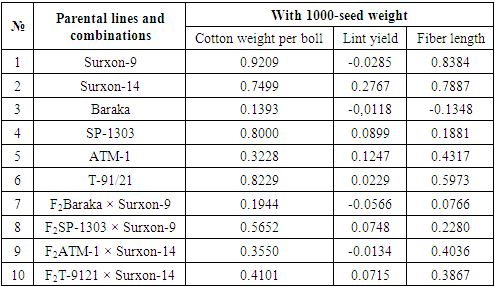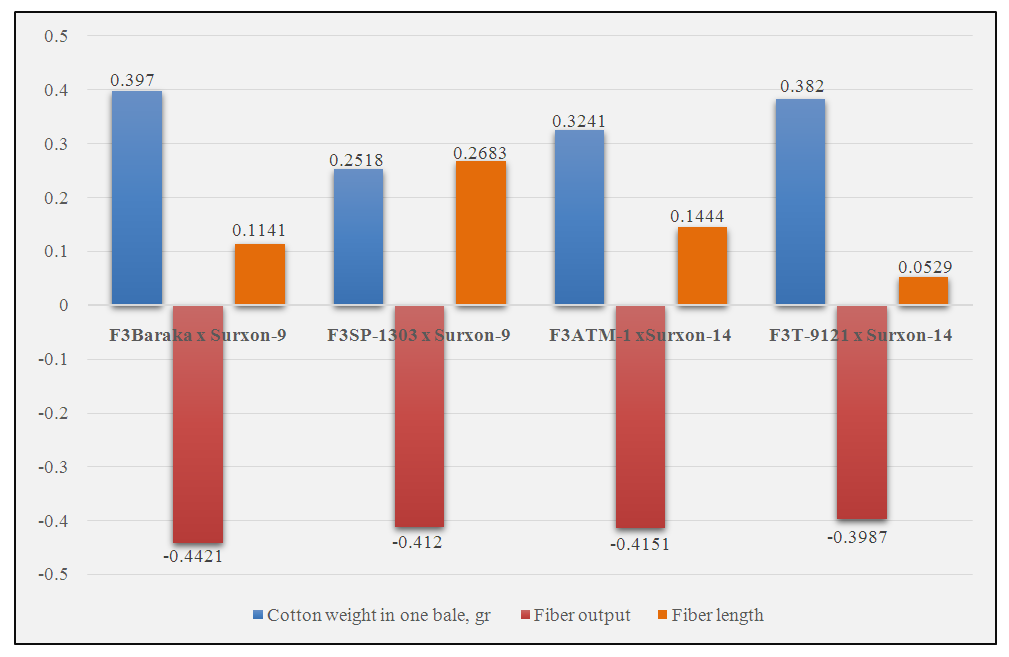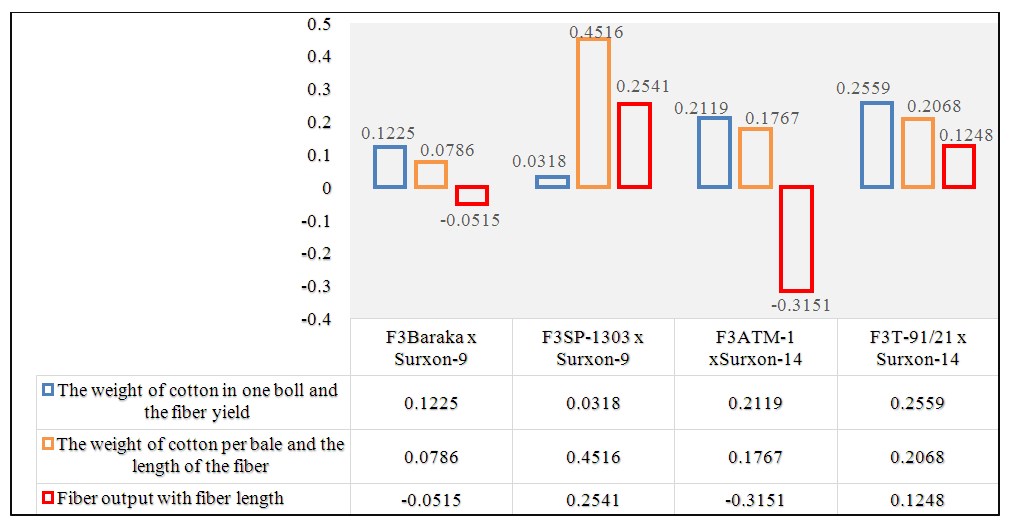Nazarbayev Khursandbek Kuvandikovich1, Boboyev Sayfulla Gofurovich2
1PhD Student, National University of Uzbekistan, Tashkent, Uzbekistan
2Doctor of Biological Sciences, Professor, Tashkent State Agrarian University, Tashkent, Uzbekistan
Copyright © 2025 The Author(s). Published by Scientific & Academic Publishing.
This work is licensed under the Creative Commons Attribution International License (CC BY).
http://creativecommons.org/licenses/by/4.0/

Abstract
This article presents correlation data among valuable agronomic traits in F2 and F3 generations of interspecific hybrids derived from crosses between G. hirsutum L. and G. barbadense L. cotton varieties. As a result of studying the correlation between valuable agronomic traits in the second and third generations of hybrids, it was revealed that there is a weak positive and negative correlation between 1000 seed weight and lint yield, a weak to moderate positive correlation with fiber length, and a moderate negative to weak positive correlation between lint yield and fiber length. Additionally, a weak to moderate positive correlation was observed between boll weight and fiber length.
Keywords:
Cotton, Variety, Interspecific hybridization, Hybridization, Correlation, Positive correlation, Negative correlation
Cite this paper: Nazarbayev Khursandbek Kuvandikovich, Boboyev Sayfulla Gofurovich, Correlation Between Valuable Agronomic Traits in F2-F3 Generations of Interspecific Hybrids of Cotton, International Journal of Genetic Engineering, Vol. 13 No. 6, 2025, pp. 97-100. doi: 10.5923/j.ijge.20251306.01.
1. Introduction
As with all agricultural crops, the cotton plant exhibits correlations among its agronomic traits, and the nature of these correlations—whether positive or negative, and whether weak, moderate, or strong—is of significant importance. Similar to other crops, traits in cotton such as earliness and yield, or yield and fiber quality, are often negatively correlated. This presents a challenge in breeding varieties that are early-maturing, high-yielding, and possess high fiber quality simultaneously. In some varieties and hybrids, these traits show strong negative correlations. Research has shown that in certain studied varieties and lines, there are weak, moderate, and strong positive correlations, as well as weak to moderate negative correlations between the number of fruiting branches and earliness [2]. However, it has been scientifically proven that the correlations among major agronomic traits can be modified using methods such as hybridization and selection. It is possible to weaken negative correlations or even convert them into positive ones. In the works of A. B. Amanturdiyev and R. G. Kim, boll weight—a complex quantitative trait—has been shown to inherit in intermediate, positive, or negative heterosis forms, depending on the combining ability of the parental lines in hybrids. It has also been observed to follow dominant and over-dominant inheritance patterns. A negative correlation between earliness and boll size has been reported; however, in the studied hybrids, a significant positive correlation was observed between boll weight and overall productivity [1,3]. In the scientific research of Sh. E. Namozov and S. G. Babayev [4], the degree of correlation between agronomic traits in cotton was categorized into three groups: the first group included traits with strong intercorrelation, such as boll weight and seed number per boll; the second group included traits with moderate correlation, such as lint yield and lint index; and the third group included weakly correlated traits, such as fiber length, 1000-seed weight, and number of unfertilized seeds.This article presents the results and analysis of a study aimed at determining the correlation between valuable agronomic traits in interspecific hybrids derived from Gossypium hirsutum L. and Gossypium barbadense L. varieties.
2. Research Object
The study was conducted using the Baraka, SP-1303, ATM-1 varieties, and the T-91/21 line of Gossypium hirsutum L., as well as the Surxon-14 and Surxon-9 varieties of Gossypium barbadense L. Interspecific hybrid generations derived from these varieties through hybridization were also included as research material.
3. Results and Analysis
In this study, correlations among agronomic traits were identified and analyzed in newly developed interspecific cotton hybrids. Trait correlations were assessed in the parental forms, as well as in F₂ and F₃ hybrid generations. The objective was to evaluate how these correlations appeared in the parent lines, how they were affected by hybridization, and whether they remained consistent or changed by the F₃ generation.The analysis began with examining the correlation between 1000-seed weight—an important yield-related trait—and other agronomic characteristics. The results revealed a strong positive correlation between 1000-seed weight and boll weight in the Surxon-9, Surxon-14, SP-1303 varieties, and the T-91/21 line. The correlation coefficients were r = 0.9209, r = 0.7499, r = 0.8000, and r = 0.8229, respectively.In ATM-1 (r = 0.3228) and Baraka (r = 0.1393), the correlation between 1000-seed weight and boll weight was weakly positive. In the F₂ hybrid generations, this correlation remained positive but varied in strength. In the F₂ Baraka × Surxon-9 combination, a weak positive correlation was observed (r = 0.1944), while in F₂ SP-1303 × Surxon-9, F₂ ATM-1 × Surxon-14, and F₂ T-91/21 × Surxon-14 combinations, moderate positive correlations were recorded, ranging from r = 0.3550 to r = 0.5652 (Table 1).Table 1. Correlation coefficients between 1000 seed weight and selected agronomic traits in parental lines and F2 hybrids
 |
| |
|
The next pair of traits analyzed was 1000-seed weight and lint yield. In the parent lines Surxon-9 (r = –0.0285) and Baraka (r = –0.0118), weak negative correlations were recorded. In contrast, Surxon-14, SP-1303, ATM-1, and T-91/21 exhibited weak positive correlations, ranging from r = 0.0229 to r = 0.2767. Among the hybrids, similarly weak correlations were observed. In F₂ Baraka × Surxon-9 (r = –0.0566) and F₂ ATM-1 × Surxon-14 (r = –0.0134), weak negative correlations were found, while F₂ SP-1303 × Surxon-9 (r = 0.0748) and F₂ T-91/21 × Surxon-14 (r = 0.0715) showed weak positive correlations. These outcomes suggest that hybridization may influence the direction and magnitude of trait correlations. Notably, Surxon-9 demonstrated a negative correlation between 1000-seed weight and lint yield, unlike most other lines.The final trait pair analyzed was 1000-seed weight and fiber length. In the G. barbadense L. varieties Surxon-9 and Surxon-14, strong positive correlations were observed, with r = 0.8384 and r = 0.7887, respectively. Among the G. hirsutum L. varieties, Baraka showed a weak negative correlation (r = –0.1348), while SP-1303 showed a weak positive correlation (r = 0.1881).In the ATM-1 variety and the T-91/21 line, moderate positive correlations were identified between 1000-seed weight and fiber length, with correlation coefficients of r = 0.4317 and r = 0.5973, respectively. Among the hybrid combinations, positive correlations were also observed for these traits. Specifically, F₂ Baraka × Surxon-9 (r = 0.0766) and F₂ SP-1303 × Surxon-9 (r = 0.2280) exhibited weak positive correlations, while F₂ ATM-1 × Surxon-14 (r = 0.4036) and F₂ T-91/21 × Surxon-14 (r = 0.3867) showed moderate positive correlations.Correlations between boll cotton weight and fiber yield were also analyzed in the studied hybrids and parental forms. Among the parent lines involved in hybridization, weak positive correlations were identified, ranging from r = 0.0676 in T-91/21 to r = 0.2555 in Surxon-9. These values suggest that there is no strong relationship between boll cotton weight and fiber yield in the parental genotypes. In the hybrid combinations, however, the nature of this relationship differed. Only the F₂ T-91/21 × Surxon-14 hybrid exhibited a weak positive correlation (r = 0.2163), whereas other combinations—F₂ Baraka × Surxon-9, F₂ SP-1303 × Surxon-9, and F₂ ATM-1 × Surxon-14—showed moderate positive correlations, with coefficients of r = 0.4164, r = 0.3370, and r = 0.5470, respectively (Table 2). Table 2. Correlation coefficients between some agronomic traits in parental forms and F2 hybrids
 |
| |
|
A strong positive correlation between boll cotton weight and fiber length was observed in the Surxon-9 (r = 0.8305) and Surxon-14 (r = 0.8500) varieties. In contrast, the Baraka variety exhibited a weak negative correlation (r = –0.2175). Weak positive correlations were identified in the SP-1303, ATM-1, and T-91/21 lines.In the studied hybrids, depending on the combination, weak to moderate positive correlations between boll cotton weight and fiber length were observed. Specifically, moderate positive correlations were recorded in the F₂ SP-1303 × Surxon-9 and F₂ T-91/21 × Surxon-14 combinations, with correlation coefficients of r = 0.3670 and r = 0.4869, respectively. The F₂ Baraka × Surxon-9 (r = 0.1314) and F₂ ATM-1 × Surxon-14 (r = 0.1017) hybrids exhibited weak positive correlations. Notably, the hybrid derived from Baraka (which showed a weak negative correlation) and Surxon-9 (which exhibited a strong positive correlation) demonstrated a weak positive correlation. This suggests that the traits of boll cotton weight and fiber length are inherited with relatively low genetic linkage.In the F₃ generation of the hybrids, the degree of correlation between agronomic traits was also assessed. The correlation between 1000-seed weight and boll cotton weight was found to be positive, with weak to moderate correlation depending on the hybrid combination. Specifically, in the F₃ Baraka × Surxon-9 and F₃ T-91/21 × Surxon-14 combinations, moderate positive correlations were observed, with correlation coefficients of r = 0.3970 and r = 0.3820, respectively. In the F₃ SP-1303 × Surxon-9 and F₃ ATM-1 × Surxon-14 combinations, weak positive correlations were recorded, with r = 0.2518 and r = 0.3241, respectively. These results indicate that the correlation pattern observed in the F₃ generation is similar to that seen in the F₂ generation.The next trait analyzed was the correlation between 1000-seed weight and fiber yield. In the F₂ generation, three combinations exhibited weak negative correlations, while one showed a weak positive correlation. In the F₃ generation, however, the correlation between these traits shifted to a moderate negative level. The correlation ranged from r = –0.3987 (F₃ T-91/21 × Surxon-14) to r = –0.4421 (F₃ Baraka × Surxon-9), indicating a negative correlation in all hybrid combinations. This suggests that an increase in 1000-seed weight is associated with a decrease in fiber yield. Furthermore, the results show that the correlation between these traits changes across generations, which may be attributed to variability in the traits themselves.In the F₃ generation of hybrids, a weak positive correlation was observed between 1000-seed weight and fiber length. A relatively stronger correlation was found in the F₃ SP-1303 × Surxon-9 combination, with a correlation coefficient of r = 0.2683. In the remaining three hybrid combinations, the correlation between these traits remained weakly positive. This suggests that the inheritance of 1000-seed weight and fiber length may be independent of one another, or, if a correlation exists, both traits tend to change in the same positive direction.Unlike the F₂ generation, where the correlation between boll weight and lint yield was moderately positive, the F₃ generation showed a weak positive correlation. Among the F₃ hybrid combinations, those involving the Surxon-9 variety—specifically F₃ Baraka × Surxon-9 and F₃ SP-1303 × Surxon-9—showed correlation coefficients of r = 0.1225 and r = 0.0318, respectively.In contrast, combinations involving the Surxon-14 variety showed correlation coefficients of r = 0.2119 and r = 0.2559, respectively.For the correlation between boll weight and fiber length, a moderate positive correlation was observed in the F₃ SP-1303 × Surxon-9 combination, with a correlation coefficient of r = 0.4516. In the other three hybrid combinations, the correlation was weakly positive (Figures 1 and 2). | Figure 1. Correlation between 1000 seed weight and boll weight, lint yield, and fiber length |
 | Figure 2. Correlation between valuable agronomic traits in F3 hybrids |
Depending on the combinations, weak negative and positive correlations were observed between lint yield and fiber length traits. In the F3 Baraka x Surxon-9 and F3 ATM-1 × Surxon-14 combinations, weak negative correlations were identified, with correlation coefficients of r = -0.0515 and r = -0.3151, respectively. In the F3 SP-1303 × Surxon-9 and F3 T-9121 × Surxon-14 combinations, positive correlations were observed, with values of r = 0.2541 and r = 0.1248, respectively. Although the correlations between these traits were weak, their direction—whether negative or positive—depended on the specific hybrid combination.
4. Conclusions
In conclusion, the study found that in hybrid combinations, there were strong, moderate, and weak positive correlations between 1000-seed weight and single boll weight; weak positive and negative correlations between 1000-seed weight and lint yield; and moderate to weak positive correlations between single boll weight, lint yield, and fiber length, depending on the combination. In the F3 generation, a moderate negative correlation was observed between 1000-seed weight and lint yield. These findings suggest that the direction and magnitude of trait correlations in hybrid combinations are influenced by the segregation processes of traits in the hybrids.
References
| [1] | Amanturdiyev A.B., Kim R.G. The structure of the boll and its relationship with morphological and agronomic traits and wilt resistance in cotton (G. hirsutum L.) – Tashkent: Fan, 2008. pp. 43–44. |
| [2] | To‘ychiyev Kh.Y. Correlation between the number of fruiting branches per plant in cotton varieties and ridges with early maturity. In: Proceedings of the Republican Scientific-Practical Conference "Achievements in Genetics and Breeding of Traits of Early Maturity and Resistance of Plants to Biotic and Abiotic Factors". – Tashkent, 2015. pp. 80–82. |
| [3] | Nazarbaev Kh.K., Nuriddinov A.N., Boboev S.G. Inheritance of some morphological characteristics in interspecific cotton hybrids. In: Proceedings of the International Conference on Scientific Research in Natural and Social Sciences. Hosted online from Toronto, Canada, January 5, 2024. pp. 1–5. |
| [4] | Namazov Sh.E., Babayev S.G‘. Opportunities of using complex interspecific hybrids in creating new donors for the cotton gene pool and breeding. // Bulletin of Agricultural Science of Uzbekistan. – Tashkent, 2006. – No. (24) 2. pp. 49–53. |




 Abstract
Abstract Reference
Reference Full-Text PDF
Full-Text PDF Full-text HTML
Full-text HTML
